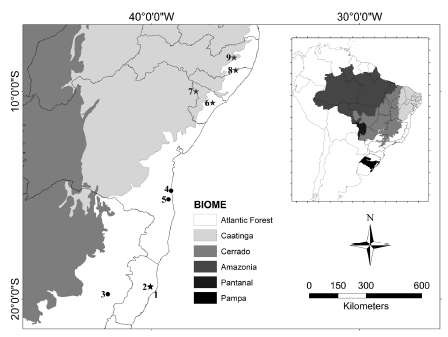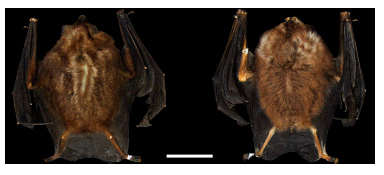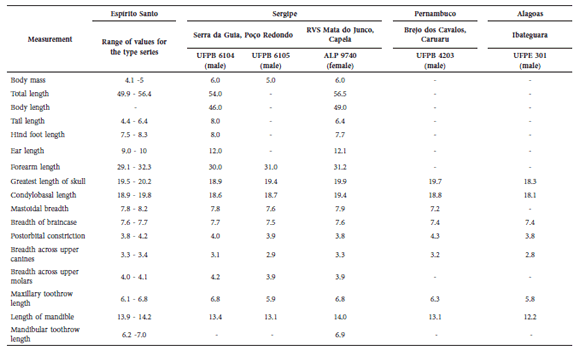Services on Demand
Journal
Article
Indicators
-
 Cited by SciELO
Cited by SciELO
Related links
-
 Similars in
SciELO
Similars in
SciELO  uBio
uBio
Share
Mastozoología neotropical
Print version ISSN 0327-9383
Mastozool. neotrop. vol.21 no.2 Mendoza Dec. 2014
NOTA
Major extension of the known range of the capixaba nectar-feeding bat, Dryadonycteris capixaba (Chiroptera, Phyllostomidae). Is this rare species widely distributed in eastern Brazil?
Patrício A. da Rocha1, 5, Anderson Feijó1, Daniela Dias2, Jefferson Mikalauskas3, Juan Ruiz-Esparza4, and Stephen F. Ferrari5
1 Universidade Federal da Paraíba, Departamento de Sistemática e Ecologia, Programa de Pós-Graduação em Zoologia, 58059-900 João Pessoa, Paraíba, Brazil [correspondence: Patrício A. da Rocha <parocha2@yahoo.com.br>].
2 Laboratório de Biologia e Parasitologia de Mamíferos Silvestres Reservatórios, Fundação Oswaldo Cruz, Pavilhão Lauro Travassos, Avenida Brasil 4365, 21040-900 Manguinhos, Rio de Janeiro, Brazil.
3 Laboratório de Mastozoologia, Instituto de Biologia, Universidade Federal Rural do Rio de Janeiro, BR 465 km 7, 23890-000 Seropédica, RJ, Brazil.
4 Universidade Federal de Sergipe, Programa de Pós-Graduação em Desenvolvimento e Meio Ambiente - PRODEMA, 49100-000 São Cristóvão, Sergipe, Brazil.
5 Universidade Federal de Sergipe, Departamento de Ecologia, 49100-000 São Cristóvão, Sergipe, Brazil.
Recibido 24 febrero 2014.
Aceptado 7 julio 2014.
Editor asociado: H Mantilla-Meluck
ABSTRACT.
Dryadonycteris capixaba Nogueira, Lima, Peracchi and Simmons, 2012 was described from 3 specimens originally identified as Choeroniscus minor (Peters, 1868) collected in the Atlantic Forest of southeastern Brazil. The present study reevaluates the geographic distribution of D. capixaba based on the re-identification of 5 specimens collected at 4 localities in northeastern Brazil, which were catalogued originally as C. minor and Lichonycteris obscura Thomas, 1895. The identification of these new specimens of D. capixaba extends the known distribution of the species northwards by approximately 1200 km, including also cloud forest enclaves within the xeric Caatinga scrub of northeastern Brazil, which may represent isolated populations.
RESUMEN.
Importante extensión del rango geográfico conocido para el murciélago nectarívoro de Capixaba, Dryadonycteris capixaba (Chiroptera, Phyllostomidae). ¿Está esta especie rara ampliamente distribuida en Brasil oriental?
Dryadonycteris capixaba Nogueira, Lima, Peracchi and Simmons, 2012 fue descrita a partir de 3 individuos inicialmente identificados como Choeroniscus minor (Peters, 1868) colectados en el Bosque Atlántico del sudeste de Brasil. Este estudio pretende reevaluar la distribución geográfica de D. capixaba con base en la reidentificación de 5 ejemplares colectados en 4 localidades en el noreste de Brasil, que fueron catalogados originalmente como C. minor y Lichonycteris obscura Thomas, 1895. La identificación de estos nuevos ejemplares de D. capixaba amplía la distribución conocida de la especie hacia el norte aproximadamente 1200 km, incluyendo también enclaves forestales nubosos encontrados en la Caatinga del nordeste de Brasil, que pueden representar poblaciones aisladas.
Key words: Atlantic Forest; Choeronycterini; Cloud forest enclaves; Geographic distribution; Lichonycteris.
Palabras clave: Bosque Atlántico; Choeronycterini; Distribución geográfica; Enclaves forestales nubosos; Lichonycteris.
The genus Dryadonycteris Nogueira, Lima, Peracchi and Simmons, 2012, represented by a single species, D. capixaba, was described based on 3 specimens from the municipality of Linhares, in the southeastern Brazilian state of Espírito Santo. These specimens were identified originally as Choeroniscus minor (Peters, 1868) by Peracchi and Albuquerque (1993) and Peracchi et al. (2011). Nogueira et al. (2012) suggested that Dryadonycteris was the only bat genus endemic to the Brazilian Atlantic Forest biome.
As a member of the tribe Choeronycterini (sensu Baker et al., 2003), D. capixaba is easily distinguished from lonchophylline and glossophagine bats by the absence of lower incisors. In comparison with other Brazilian choeronycterines (Anoura Gray, 1838, Choeroniscus Thomas, 1928, Lichonycteris Thomas, 1895, and Scleronycteris Thomas, 1912), Dryadonycteris is distinguished by a set of unique distinct external and craniodental traits, including the tricolored banding pattern of the dorsal pelage; plagiopatagium inserted at the base of the toes; uropatagium long, extending past knees; calcar and foot subequal in length; well developed pre-maxilla; inflated anterior maxilla and presence of 2 foramina between premaxillae (Wetterer et al., 2000; Griffiths and Gardner, 2008; Nogueira et al., 2012). Detailed morphological comparisons of the choeronycterine genera are provided by Nogueira et al. (2012).
Although the type series was originally identified as C. minor, the general appearance of Dryadonycteris is closely related to that of Lichonycteris; both genera have similarities in body size, the tricolor banding pattern of dorsal pelage, and the insertion of the plagiopatagium at the base of the fingers. In addition, there is a possibility that the D. capixaba and Lichonycteris obscura Thomas, 1895 are potentially sympatric at the Atlantic Forest of southeastern Brazil (Nogueira et al., 2012). The above mentioned aspects raised the need of a reevaluation of the identification of choeronycterine specimens from other locations in eastern Brazil identified as C. minor and L. obscura.
In the present study we revised the identification of 5 specimens cataloged as C. minor and L. obscura, from 4 localities in northeastern Brazil (Fig. 1), deposited in 3 zoological collections: Coleção Adriano Lúcio Peracchi (ALP), Universidade Federal Rural do Rio de Janeiro, Coleção de Mamíferos da Universidade Federal da Paraíba (UFPB) and Coleção de Mamíferos da Universidade Federal de Pernambuco (UFPE). Three of these specimens were collected by the authors in Sergipe, including an adult female (ALP 9740), previously identified as C. minor, which was captured at Refúgio da Vida Silvestre Mata do Junco (10º32'S, 37º03'W), a 800-ha protected area of Atlantic Forest with a well structured forest surrounded by sugarcane (Saccharum sp.) plantations in the municipality of Capela. Two adult males (UFPB 6104, UFPB 6105) were captured at a second site called Serra da Guia (9º58'S, 37º52'W) in the municipality of Poço Redondo in July and August, 2009, respectively. These specimens were reported as L. obscura by Leal et al. (2013), based on the preliminary identification in an unpublished dissertation (Rocha, 2010). Both specimens were caught with mist nets set in a cloud forest refuge at the top of the mountain range, at an altitude of approximately 750 m. This small patch of forest has a well structured canopy of up to 20 m in height, which is quite distinct from the dry Caatinga scrub habitats of the surrounding area.

Fig. 1. Records of Dryadonycteris capixaba (stars) and Choeroniscus minor (circles) from the Brazilian Atlantic Forest (compiled after Aguiar et al., 1995; Sousa et al., 2004; Faria et al., 2006; Nogueira et al., 2012, and the present study): Espírito Santo, (1) Reserva Natural Vale (type locality of D. capixaba), (2) Floresta Nacional de Goytacazes, Linhares; Minas Gerais, (3) Caratinga; Bahia, (4) Ilhéus, (5) Uma; Sergipe, (6) Refugio de Vida Silvestre Mata do Junco, Capela, (7) Serra da Guia, Poço Redondo; Alagoas, (8) Ibateguara; Pernambuco, (9) Caruaru. Dark stars: localities of the type series; blue stars: new records in the Atlantic Forest; green stars: new records in the cloud forest enclaves.
Two additional specimens also identified as C. minor were examined. One specimen (UFPE 301) was collected in the cloud forest at Brejo dos Cavalos (8º22'S, 36º01'W) in the municipality of Caruaru, Pernambuco (Souza et al., 2004). Finally, the other unpublished specimen (UFPB 4203) was collected in an area of Atlantic Forest in Ibateguara (8º56'S, 35º53'W), Alagoas.
All the mentioned specimens present the unique combination of characters that distinguish D. capixaba from the other choeronycterin genera (Nogueira et al., 2012), such as (1) lower edge of the horseshoe confluent with the upper lip, (2) lateral edges of the horseshoe confluent with the face on the inferior margin, but with superior edge free, (3) small ears, with rounded tips and strongly convex inner margins, (4) dorsal and ventral surfaces of the forearm covered with fur, (5) plagiopatagium inserted at the base of the toes, (6) long uropa tagium, extending past the knees and the short tail, (7) calcar approximately the same length as the foot, (8) dorsal fur tricolored, with a pale brown base and narrow dark brown tip, separated by an ample, cream-colored middle band (Fig. 2), (9) premaxillae well developed, (10) presence of 2 foramina between premaxillae, (11) anterior portion of the maxilla inflated conspicuously (Fig. 3), (12) presence of well developed diagonal lines on the orbital portion of the frontal bones, (13) coronoid process as high as the mandibular condyle, (14) U-shaped upper incisor arcade (Fig. 3), and (15) first lower premolar with concave lingual surface. The dental formula of the specimens - I 2/0, C 1/1, P 2/3, M 3/3 × 2 = 30 - is also the same as that of D. capixaba. The measurements of the specimens analyzed, obtained following the guidelines in Vizotto and Taddei (1973), are also generally consistent with those recorded for the type series (Table 1).

Fig. 2. Views of dorsal (left) and ventral (right) fur of a male Dryadonycteris capixaba (UFPB 6104) from Serra da Guia, Sergipe, northeastern Brazil. Note the distinct tricolored pattern of the dorsal fur banding. Scale bar = 20 mm.

Fig. 3. Dorsal, ventral, and lateral views of the cranium and lateral view of the mandible of a male Dryadonycteris capixaba (UFPB 6104) from Serra da Guia, Sergipe, northeastern Brazil. Scale bar = 10 mm.
Table 1. Selected measurements (weight in grams, all other values in mm) of specimens of Dryadonycteris capixaba from 4 localities in northeastern Brazil and the type series from Linhares, Espírito Santo (after Nogueira et al., 2012). The collection acronyms are detailed in the main text.

The results of the present study constitute a major advance in the understanding of the zoogeography of D. capixaba, given that the northernmost sites are 1200 km north of the type locality of this species in the southeast of the country. Assuming that the known localities do not represent 2 isolated populations in the north and south of the Atlantic Forest, it would seem reasonable to conclude that the species is distributed throughout most of this biome on the tropical eastern coast of Brazil, although it is presumably rare at most sites.
In addition, while Nogueira et al. (2012) suggested that the species (and genus) is endemic to the Atlantic Forest, the herein analyzed specimens from Serra da Guia and Brejo dos Cavalos indicate the occurrence of the species within the neighboring Caatinga xeric scrublands of northeastern Brazil, albeit in isolated enclaves of cloud forest, which are considered to be Atlantic Forest refugia (Andrade-Lima, 1982). In the specific case of Serra da Guia, the small size of the cloud forest enclave - approximately 25 hectares - suggests that the local D. capixaba almost certainly utilize the Caatinga scrub, even if they may not be permanent residents in this ecosystem. On the other hand, the association with cloud forest suggests that they may be dependent on mesic habitats. The cloud forest enclaves of the Brazilian Northeast are known for their faunal diversity, including many endemic and endangered species (Andrade and Lins, 1964; Theulen, 2004; Pereira Filho and Montingelli, 2011).
Based on this reassessment of the available specimens, C. minor would now be restricted to only 3 sites in the Atlantic Forest (Fig. 1), all relatively close to the type locality of D. capixaba - Ilhéus and Una in southern Bahia (Faria et al., 2006), and Caratinga in eastern Minas Gerais (Aguiar et al., 1995). The specimens from Minas Gerais are similar in size to D. capixaba (Nogueira et al., 2012), but smaller than the C. minor specimens collected in French Guiana (Simmons and Voss, 1998). Given the findings presented here, it seems likely that these specimens may also represent D. capixaba. In the original description of Nogueira et al. (2012), these individuals were not available for analysis. Assuming that these specimens do in fact represent D. capixaba, the geographic range of C. minor would be restricted to the Amazon basin and adjacent areas of northern and northwestern South America.
Acknowledgments.
We are grateful to Jadson Brito for technical assistance, to Diego de Moraes Astúa for access to the collection of mastozoology of the UFPE. AF and PAR were supported by graduate stipends from CAPES. SFF (processes 302747/2008-7 and 483220/2013) and PAR (501701/2013-3) thank CNPq for research stipends.
LITERATURE CITED
1. AGUIAR LMS, M ZORTÉA, and VA TADDEI. 1995. New records of bats from the Brazilian Atlantic Forest. Mammalia 59:667-671. [ Links ]
2. ANDRADE GO and RC LINS. 1964. Introdução ao Estudo dos "Brejos" Pernambucanos. Arquivos do Instituto de Ciências da Terra 2:21-33. [ Links ]
3. ANDRADE-LIMA D. 1982. Present day forest refuges in Northeastern Brazil. Pp.245-254, in: Biological diversification in the Tropics (GT Prance, ed.). Columbia University Press, New York. [ Links ]
4. BAKER RJ, SR HOOFER, CA PORTER, and RA VAN DEN BUSSCHE. 2003. Diversification among New World leaf-nosed bats: an evolutionary hypothesis and classification inferred from digenomic congruence of DNA sequence. Occasional Papers, Museum of Texas Tech University 230:1-32. [ Links ]
5. FARIA D, B SOARES-SANTOS, and E SAMPAIO. 2006. Bats from the Atlantic rainforest of southern Bahia, Brazil. Biota Neotropica 6(2):1-13. [ Links ]
6. GRIFFITHS TA and AL GARDNER. 2008. Subfamily Glossophaginae Bonaparte, 1845. Pp 224-244, in: Mammals of South America. Vol. 1. Marsupials, xenarthrans, shrews, and bats (AL Gardner, ed.). Chicago, Chicago University Press. [ Links ]
7. LEAL ESB, SM AZEVEDO-JUNIOR, FVP VILA NOVA, DQ GUERRA, and WR TELINO-JUNIOR. 2013. Updated compilation of bat species (Chiroptera) for the Brazilian state of Sergipe, including new records. Chiroptera Neotropical 19:1163-1178. [ Links ]
8. NOGUEIRA MR, IP LIMA, AL PERACCHI, and NB SIMMONS. 2012. New Genus and Species of Nectar- Feeding Bat from the Atlantic Forest of Southeastern Brazil (Chiroptera: Phyllostomidae: Glossophaginae). American Museum Novitates 3747:1-30. [ Links ]
9. PERACCHI AL and ST ALBUQUERQUE.1993. Quirópteros do município de Linhares, Estado do Espírito Santo, Brasil (Mammalia, Chiroptera). Revista Brasileira de Biologia 53:575-581. [ Links ]
10. PERACCHI, AL, IP LIMA, NR REIS, MR NOGUEIRA, and H ORTÊNCIO FILHO. 2011. Ordem Chiroptera. Pp. 155-234, in: Mamíferos do Brasil (NR Reis, AL Peracchi, WA Pedro, and IP Lima, eds.). Londrina, Editora da Universidade Estadual de Londrina. [ Links ]
11. PEREIRA FILHO GA and GG MONTINGELLI. 2011. Checklist of snakes from the Brejos de Altitude of Paraíba and Pernambuco, Brazil. Biota Neotropica 11:145-151. [ Links ]
12. ROCHA PA. 2010. Diversidade, composição e estrutura de comunidade de morcegos (Mammalia: Chiroptera) em habitats de Caatinga e Brejo de Altitude do Estado de Sergipe. Master thesis, Universidade Federal de Sergipe, Aracaju, Sergipe, Brasil. [ Links ]
13. SIMMONS NB and RS VOSS. 1998. The mammals of Paracou, French Guiana: A Neotropical lowland rainforest fauna. Part 1. Bats. Bulletin of the American Museum of Natural History 237:1-219. [ Links ]
14. SOUSA MAN, A LANGGUTH, and EA GIMENEZ. 2004. Mamíferos dos Brejos de Altitude Paraíba e Pernambuco. Pp. 229-254, in: Brejos de Altitude de Pernambuco e Paraíba: História Natural, Ecologia e Conservação (K Porto, JJP Cabral, and M Tabarelli, eds.). Série Biodiversidade. Ministério do Meio Ambiente. Brasília. [ Links ]
15. THEULEN V. 2004. Conservação dos Brejos de Altitude no Estado de Pernambuco. Pp.299-302, in: Brejos de Altitude em Pernambuco e Paraíba, História Natural, Ecologia e Conservação (KC Porto, JJP Cabral, and M Tabarelli, eds.). Ministério do Meio Ambiente, Brasília. [ Links ]
16. VIZOTTO LD and VA TADDEI. 1973. Chave para a determinação de quirópteros brasileiros. Revista da Faculdade de Filosofia, Ciências e Letras de São José do Rio Preto 1:1-72. [ Links ]
17. WETTERER AL, MV ROCKMAN, and NB SIMMONS. 2000. Phylogeny of phyllostomid bats (Mammalia, Chiroptera): data from diverse morphological systems, sex chromosomes, and restriction sites. Bulletin of the American Museum of Natural History 248:1-200. [ Links ]














